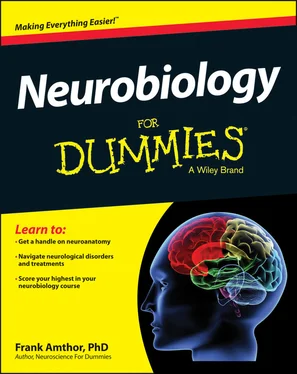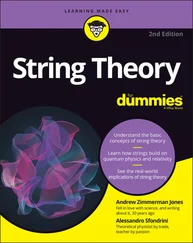A separate Nernst equation is written for each ion. The Nernst equation giving the equilibrium potential for sodium, E Na, would be written as follows:
ENa = 59.8 mV log10 ([Na+]outside/[Na+]inside)
The constant 59.8 mV comes from the evaluation of several other constants (RT/zF), where R = the universal gas constant, T = temperature in degrees Kelvin, F = Faraday’s constant, and z = the ion valence (for Na +z = 1).
For a typical neuron frequently studied, like the squid axon, Na insidemight equal 50 mM (millimolar), whereas Na outsideis typically 440 mM.
This gives
ENa = 59.8 mV log10 (440/50) = 56.5 mV
What this means is that the potential inside the neuron would have to be raised from its –60 millivolt (mV) resting potential to +56.5 mV to balance the tendency of sodium ions to rush into the neuron by diffusion due to the much higher concentration outside than inside.
For potassium, where the concentrations are about 400 mM inside versus 20 mM outside, E K= 59.8 mV log 10([K +] outside/[K +] inside) = 59.8 mV log 10(20/400) = –77.8 mV.
This means that the potential inside the cell would have to be made more negative than –77.8 mV to keep potassium from going outside the cell through a membrane permeable to potassium due to the much larger concentration of potassium inside the cell than outside.
For chloride, E Cl= 59.8 mV log 10([Cl –] outside/[Cl –] inside) = –59.8 mV log 10(560/52) = –61.7 mV.
Note that a minus sign (–) appears in front of the 59.8 constant because the valence, z, of chloride is negative (–1). The reversal potential for chloride is often near the resting potential because chloride leak channels (channels without gates) exist in most neurons. These channels are always open and allow chloride to move through the membrane until its equilibrium potential is reached.
The concentration of chloride ions is much higher outside the cell than inside for the equilibrium potential of about –60 mV, close to the resting potential of many cells. The negative charge inside the cell compared to outside repels negative chloride ions. Also, many organic ions exist inside a cell that are negatively charged.
 Chloride channels may be inhibitory even if the reversal potential for chloride is slightly above the resting potential. That’s because opening chloride channels will oppose depolarization by opening nearby sodium channels. Moreover, the open chloride channels reduce the membrane resistance, and by Ohm’s law (V = I · R), reduce the depolarizing voltage produced by sodium currents.
Chloride channels may be inhibitory even if the reversal potential for chloride is slightly above the resting potential. That’s because opening chloride channels will oppose depolarization by opening nearby sodium channels. Moreover, the open chloride channels reduce the membrane resistance, and by Ohm’s law (V = I · R), reduce the depolarizing voltage produced by sodium currents.
The Goldman–Hodgkin–Katz equation
The Nernst equation (refer to the previous section) tells you what the reversal potential would be for a single ion. But multiple ionic concentration differences exist across the neural membrane, and the most important are sodium, potassium, and chloride. But another question is, given the concentration differences of these different ions, what is the actual membrane potential for a given set of permeabilities to the different ions?
 The Goldman–Hodgkin–Katz equation determines the voltage that results from ionic currents across the membrane. It expands on the Nernst equation by taking into account multiple ions and their individual permeabilities (that is, if you eliminate all but one ion from the Goldman equation, you get the Nernst equation). What the Goldman equation shows is that, for a given set of ionic concentration gradients across the membrane, the voltage inside the cell (across the membrane) will be driven toward the Nernst equilibrium potential of the most permeable ion.
The Goldman–Hodgkin–Katz equation determines the voltage that results from ionic currents across the membrane. It expands on the Nernst equation by taking into account multiple ions and their individual permeabilities (that is, if you eliminate all but one ion from the Goldman equation, you get the Nernst equation). What the Goldman equation shows is that, for a given set of ionic concentration gradients across the membrane, the voltage inside the cell (across the membrane) will be driven toward the Nernst equilibrium potential of the most permeable ion.
The Goldman–Hodgkin–Katz equation is as follows:
 The chloride versus terms are reversed in the numerator and denominator of the Goldman-Hodgkin-Katz equation. This takes into account that z for chloride is –1, while it is +1 for sodium and potassium.
The chloride versus terms are reversed in the numerator and denominator of the Goldman-Hodgkin-Katz equation. This takes into account that z for chloride is –1, while it is +1 for sodium and potassium.
The Goldman–Hodgkin–Katz equation was derived from the Nernst equation but takes into account the important fact that the membrane potential tends to move toward the reversal potential of the ion to which the membrane is most permeable. Note that, if you set the permeabilities of two of the ions to zero, the Goldman–Hodgkin–Katz equation reduces to the Nernst equation for the remaining ion that has some finite permeability.
The neuron is at its resting potential when it isn’t being stimulated, or excited. The permeability for chloride tends to be high in the resting state of neurons, so the chloride current contribution is relatively dominant then.
The potassium current also pulls the membrane potential toward the potassium reversal potential because the resting membrane permeability is much higher to potassium than sodium. The reversal potential for potassium is generally more negative than the resting potential (–75 mV versus –65 mV).
During an action potential, however, the sodium permeability becomes much higher than the potassium permeability, so the intracellular potential is driven toward the positive sodium equilibrium potential. In the next section, I show you what happens when the membrane permeability for sodium and potassium ions are regulated by voltage-gated ion channels.
Signaling with Electricity in Neurons
The sodium-potassium pump (refer to the section “ Pumping Ions for Information,” earlier in this chapter) creates large concentration imbalances between the neuron’s cytoplasm and the extracellular fluid, and a net negative charge inside the neuron of about –65 mV (that is, the resting potential). How the neuron uses these concentration and charge imbalances for information processing is fundamental to what they do. Gated ion channels (refer to the “ Ion selective channels” section, earlier in this chapter) change the neuron’s permeability to particular ions. These permeability changes lead to ionic current flow and corresponding changes in the membrane potential. Membrane potential changes control voltage-gated channels and neurotransmitter release.
In the following sections, we discuss what happens when the ionic permeability changes, specifically in the action potential.
The resting potential is the voltage across the membrane when the neuron is not strongly driven by excitatory inputs. It’s established by ionic gradients and charge imbalances that occur because the sodium-potassium transporter pumps are constantly working. At this resting potential in most neurons, some leakage current flows through open chloride channels and a small conductance of potassium channels.
If we use the Goldman–Hodgkin–Katz equation (refer to the “ Goldman–Hodgkin–Katz equation” section, earlier in this chapter) to solve for the voltage across the membrane given the sodium, potassium, and chloride permeabilities, we get a resting potential of about –65 mV. (In most cells, this value varies somewhat across neurons.) Because chloride passively distributes its concentration across the membrane — due to diffusion and electric field forces created by sodium-potassium pumps — we find that the resting membrane potential is due mostly to the resting potassium conductance. Opening sodium channels that depolarize the inside of the neuron change all this drastically.
Controlling ion permeability: Gated channels
Читать дальше

 Chloride channels may be inhibitory even if the reversal potential for chloride is slightly above the resting potential. That’s because opening chloride channels will oppose depolarization by opening nearby sodium channels. Moreover, the open chloride channels reduce the membrane resistance, and by Ohm’s law (V = I · R), reduce the depolarizing voltage produced by sodium currents.
Chloride channels may be inhibitory even if the reversal potential for chloride is slightly above the resting potential. That’s because opening chloride channels will oppose depolarization by opening nearby sodium channels. Moreover, the open chloride channels reduce the membrane resistance, and by Ohm’s law (V = I · R), reduce the depolarizing voltage produced by sodium currents. The Goldman–Hodgkin–Katz equation determines the voltage that results from ionic currents across the membrane. It expands on the Nernst equation by taking into account multiple ions and their individual permeabilities (that is, if you eliminate all but one ion from the Goldman equation, you get the Nernst equation). What the Goldman equation shows is that, for a given set of ionic concentration gradients across the membrane, the voltage inside the cell (across the membrane) will be driven toward the Nernst equilibrium potential of the most permeable ion.
The Goldman–Hodgkin–Katz equation determines the voltage that results from ionic currents across the membrane. It expands on the Nernst equation by taking into account multiple ions and their individual permeabilities (that is, if you eliminate all but one ion from the Goldman equation, you get the Nernst equation). What the Goldman equation shows is that, for a given set of ionic concentration gradients across the membrane, the voltage inside the cell (across the membrane) will be driven toward the Nernst equilibrium potential of the most permeable ion. The chloride versus terms are reversed in the numerator and denominator of the Goldman-Hodgkin-Katz equation. This takes into account that z for chloride is –1, while it is +1 for sodium and potassium.
The chloride versus terms are reversed in the numerator and denominator of the Goldman-Hodgkin-Katz equation. This takes into account that z for chloride is –1, while it is +1 for sodium and potassium.










